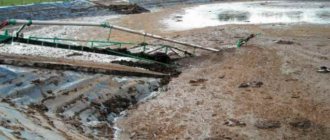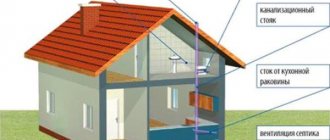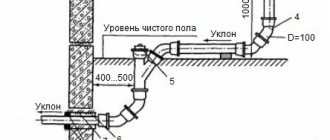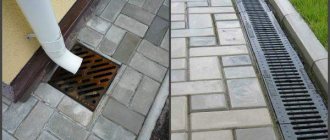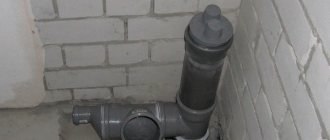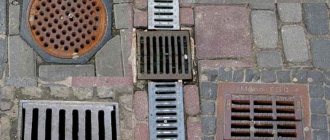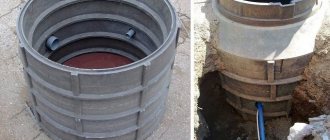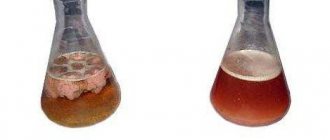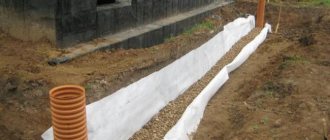Sewerage for country houses
Often in urban areas you can find signs indicating the security zones of electrical cables. But rarely does anyone manage to see the designated sewerage security zone, although external utility networks in populated areas are laid almost everywhere. In case of damage by third parties, the law provides for administrative liability with the imposition of a fine on the perpetrators. But the law does not establish liability for the absence of warning signs about the presence of security zones.
General concepts
Sewer protection zones are areas that surround sewer network structures, bodies of water and airspace, where in order to provide protection to sewer systems, the use of certain actions or immovable objects is limited.
In such areas, it is necessary to refrain from such actions that contribute to harm to the structures of the sewer system:
- plant trees;
- obstruct passage to communication structures of the outlet network;
- produce a warehouse of materials;
- engage in construction, mining, blasting, piling work;
- carry out lifting work near buildings without the permission of the owner of the sewer network;
- carry out near networks located near water bodies, moving soil, dredging the bottom, immersing solids, pulling logs, chains, anchors of water vehicles.
The security zone + sewerage have their own boundary limits, which are set taking into account:
- location;
- appointments;
- diameter of buildings;
- gasket depth.
As a rule, boundaries are prescribed in a decree issued by the Minister of the Environment, but exact information can be obtained from local governments or water and sewerage organizations.
Consequences of not knowing the existence of protected areas
Ground collapse in a protected area
In our lives, we can often encounter damage to the external parts of the sewer system, which exceed the number of cases on communication lines, power supply or water supply.
This happens because construction and excavation workers carry out actions without knowing that there is a sewer protection zone in this area, and in the process cause damage to the drainage system.
What is the reason for this ignorance? Installation of warning signs about the presence of, for example, a pipeline or cable on the territory is the responsibility of the organizations that operate this facility.
Cases of installation of watermarks are prescribed in the Water Code, special signs - in other regulations and laws.
But the case of installing a sign that there is a sewer protection zone on the territory is not regulated by documents.
As a result, if communications are damaged, the operating organization bears responsibility if the sign is not installed, and if the sign is ignored, the work contractor bears responsibility. It is not legally established that owners of sewer networks must mark the territory of the security zone with signs.
Attention. However, in case of damage to sewer networks and buildings, the work contractor is subject to administrative liability by law (Administrative Code, Article 7.7).
This is what directly concerns damage to sewerage structures.
If the actions of the work manufacturer, in addition to damaging the system, led to a detrimental effect on the environment, then this is a different type of offense that bears a different type of liability.
Warning
Advice. So, in order to avoid getting into a difficult situation that entails serious troubles, you should thoroughly study the area where you plan to carry out a certain type of work.
An analysis of the area for the presence of sewer mains and protected areas can be obtained from your local water and sewer company.
It is best to review a copy of the plan. Provided that a security zone is present on the territory, permission must be obtained to carry out work.
Regulatory requirements for the use of security zones
What actions can be carried out near sewer networks, and which are prohibited? Regulatory requirements on these issues are regulated by SNIP (40-03-99; 3.05.04-85; 2.05.06-85).
Attention. Sanitary norms and rules determine general requirements and standards. Region-specific values and rules are established by representatives of local governments.
Under normal environmental conditions, the security zone of the pressure sewer on the sides of the sewer is 5 m.
According to the resolutions of city water supply and sewerage organizations, a security zone is established in open areas and street passages:
- near networks not exceeding a diameter of 600 mm - 5 m from the outer walls of the pipeline or the extreme protruding point of the structure;
- near highways exceeding a diameter of 1000 mm - 10-25 m from structures or communication pipes, depending on the purpose of the network and the soil.
The following work is prohibited in the protected zone:
- engage in the construction of temporary or permanent structures;
- organize parking for vehicles;
- arrange landfills;
- plant shrubs and trees at a distance of less than three meters from the pipeline;
- raise or lower the existing ground level by cutting or filling;
- to construct temporary or permanent road surfaces from reinforced concrete slabs;
- use impact mechanisms close to the network sewerage structure (possibility of use - at a distance of 15 m);
- block free access to sewerage structures, wells, networks;
- lay the subway at a distance of less than 20 m from existing sewer collectors.
What is the security zone of the sewerage system according to snip?
Sanitary protection zones for water supply facilities are spaces that allow the protection of aquifers and adjacent soils from polluting factors, as well as contributing to the complete safety of technical structures. Options for the parameters of such safety belts are described in detail in SanPiN 2.14.1110-02.
After an artesian well is drilled, water quality tests need to be done. The following parameters are checked:
- Organoleptic and physical properties of drinking water: taste, color, degree of transparency, presence of various inclusions.
- Chemical composition, presence of inorganic and organic compounds, their concentration.
- Radiometric control, absence of dangerous isotopes.
- Microbiological composition, the presence of pathogenic bacteria, viruses, protozoa.
The conclusion is issued by the territorial division of the State Sanitary and Epidemiological Supervision. If there are no deviations from sanitary standards in all research protocols conducted by a certified laboratory, the water is recognized as suitable for drinking and cooking.
If minor inconsistencies with the requirements are identified, the operation of the well is allowed only as a source of water for technical needs.
Security zone of the water pipeline (water pipeline): how many meters from the underground pipeline, SNiP and SP
The security zone of the water supply system is a special term for determining the required distance from the water supply system, water conduit and water intake, which is subject to strict compliance with SNiP and SP standards.
The main current distancing standards were developed on the basis of conducted and recorded scientific research in the field of sanitation and hygiene - SanPiN. Protection zones are aimed at preventing contamination of water sources.
SNiP and its updated version - SP - determine the distance of water supply facilities from potential threats.
What is a protected area
A security zone is one of the types of zones with special conditions for the operation or protection of certain territories, the size and content of which are regulated by the current legislation of the Russian Federation. The concept of a protected area includes:
- actually, security (ensuring the integrity and absence of damage to both the structure itself and the potential harm that the object protected by fencing or legal norms may cause;
- the sanitary protection zone performs a dual function - sanitary, anti-epidemiological and protective - protection and removal from structures that pose a potential threat of damage;
- water protection zones that prevent pollution of water bodies from which the population is likely to be supplied with water;
- sanitary protection zones for sources of drinking water and liquids for household supplies;
- other protection zones - near airfields, floods, protected cultural and historical sites.
The goals of legislative restrictions carried out at the federal level are to approve special operating conditions or exclude them from use other than for their intended purpose. The distance at which objects should be located from areas of cultural or historical heritage may be determined by a regional government decree.
Fishing and water protection territories and their delimitation are fixed at the level of federal legislation. How many meters in each direction is the security zone of gas and oil pipelines, oil product and ammonia pipelines, pipelines to fully satisfy the household needs of the population is determined by the relevant SNiP, SanPiN and SP.
Sanitary standards for water pipes
According to sanitary standards and rules, the sanitary zone is the distance that must be maintained from any pipe in which water is transported. Moreover, regardless of its personal or state affiliation, whether it is filled from underground or above-ground sources.
The sanitary zone of the water supply is a distance that must be observed to prevent potential contamination of water supply networks or other sources of water supply.
Since SanPiN, which defines the protective territory, was created on the basis of Federal Law No. 52, non-compliance with the requirements threatens serious troubles for violators of existing rules. In this regard, it is worth noting the following:
- missing or created in violation of existing standards, protected areas and sanitary water supply zones are punishable by a fine, often quite significant for the budget;
- the operation of communications, in accordance with existing regulations, is regulated by the Code of Administrative Offenses (CAO);
- Violation of sanitary zones of reservoirs and other water supply sources can amount to up to 40 thousand rubles for legal entities, and up to 2 thousand rubles for individuals. and more depending on the severity of the offense committed;
- the water supply area cannot be used for any type of construction or reconstruction, unless we are talking about structures that are directly important for its functioning or protective measures of a sanitary and epidemiological nature;
- the water supply zone presupposes the absence in the immediate vicinity of sewerage, wastewater, and agricultural land in which pesticides are used;
- Strict restrictions are imposed on proximity to garbage dumps, burial of any type of waste, and even on logging, unless it is unsanitary.
Responsibilities of the work producer
Working sewer systems are the key to good life support for city citizens, therefore, when carrying out work in the protected zone, the organizer of this work is obliged to:
- adhere to strict adherence to rules and regulations;
- ensure through their actions the safety and integrity of sewerage structures in the work area;
- in case of detection of inconsistencies in kind with the analysis provided by the water supply and sewerage organizations, take precautionary measures and suspend the work until a further decision;
- remove snow, ice, and debris in a timely manner to ensure free access to sewerage facilities;
- When handing over the object, invite a representative of the body that issued the permit to the commission.
These measures apply to producers operating in open areas.
When is a sanitary protection zone design required for sewage treatment facilities?
There are three cases when it is necessary to assess the size of a sanitary protection zone for structures.
- When designing and constructing new facilities. The degree of danger, calculated or actual performance is pre-established.
- When upgrading equipment. If the installation productivity increases, it may be necessary to increase, and if it decreases, to reduce the width of the sanitary protection zone.
- To establish the satisfactory or unsatisfactory nature of the initially defined sanitary zone. For example, at the request of Rospotrebnadzor, which responds to citizens’ complaints.
Size of the security zone
As we described above, according to SNIP, the security zone under normal conditions is equal to the 5-meter mark from the side walls of the sewer pipes.
This value is applicable for gravity and pressure drainage systems. In addition, the size of the protection zone is influenced by special environmental conditions.
These include:
- high seismic hazard of the site;
- low average annual temperature in a certain region;
- high humidity or weak soil.
Typically, local authorities apply in this case an increase of five meters.
The storm sewer security zone is established in a similar way. Please note: storm sewers are designed to receive conditionally clean industrial and atmospheric wastewater that does not require treatment before discharge.
If we judge the damage to the storm sewer, then it can be caused not only by incorrect use of the security zone, but also by technical violations in the installation of sewer pipes of this type.
Advice. So, when installing storm sewer systems, and indeed other types of sewer systems, it is necessary to comply with the existing requirements and technical conditions. As with any work, some deviations and defects are possible, but their size should not affect the performance of the sewer system.
What features are taken into account when calculating the security zone?
How many meters should you leave to the water source? Foundation? People try to find answers to these questions on the Internet, but they only need to refer to established standards. So, the INSTALLATION of a well tells you at what distance from it the sewerage system should be located. What environmental parameters are used for calculations?
- Seismological activity;
- Average temperatures;
- Available humidity indicators;
- Soil characteristics.
Today, the simplest drainage system is based on the data presented. They are shown for different regions, so it’s easiest to check with professionals for details. If this is not possible, USTAN and GOSTs will come to the rescue. Using the data from them, it will be possible to draw certain conclusions that will allow you to quickly carry out the required work.
